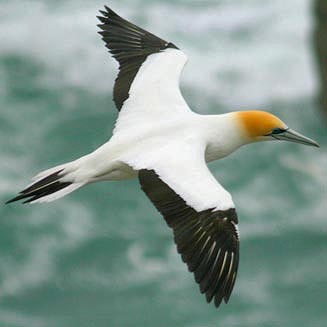Australiese malgas [Afrikaans]; Australische
jan-van-gent [Dutch]; Fou austral [French]; Australtölpel [German];
Alcatraz-australiano [Portuguese]
 |
|
|
Australian gannet, Muriwai gannet colony, North
Island, New Zealand. [photo
Alex Skene
©] |
|
Distribution and habitat
It breeds on islands around New
Zealand and Australia, while after the breeding season it disperses across the
Tasman Sea and Australian coast, sometimes travelling across the Indian Ocean to
Africa. It is generally rare in southern Africa, although it is increasingly commonly
reported in the Cape gannet colonies scattered
across the southern African coastline, where it may even breed. Its head is more
orange and its call is louder than the Cape gannet, but it is much harder to
identify at sea than at colonies, where it sticks out like a sore thumb.
Predators and parasites
It has been
recorded as prey of
Macronectes
giganteus (Southern giant-petrel).
Movements and migrations
Adults remain quite
close to their colony, while juveniles and immature birds move more
freely. It usually doesn't breed in southern Africa, however it may
build nests and display to Cape gannets.
It has also been recorded to preen Cape
gannet chicks, and may even mate with adults and produce hybrid
chicks.
Food
It mainly eats schooling fish, such
as sardines (Sardinops sagax) and anchovies (Engraulis australis),
caught by plunge-diving from about 20 metres above the sea. The following food items have been recorded
in its diet:
Breeding
It usually doesn't
breed in southern Africa, however it may build nests and display to
Cape gannets. It has also been
recorded to preen Cape gannet
chicks, and may even mate with adults and produce hybrid chicks.
Threats
Not threatened, although some of
its colonies have disappeared, its total population still increased in the 20th
century.
References
-
Hockey PAR, Dean WRJ and Ryan PG 2005. Roberts
- Birds of southern Africa, VIIth ed. The Trustees of the John Voelcker
Bird Book Fund, Cape Town.
